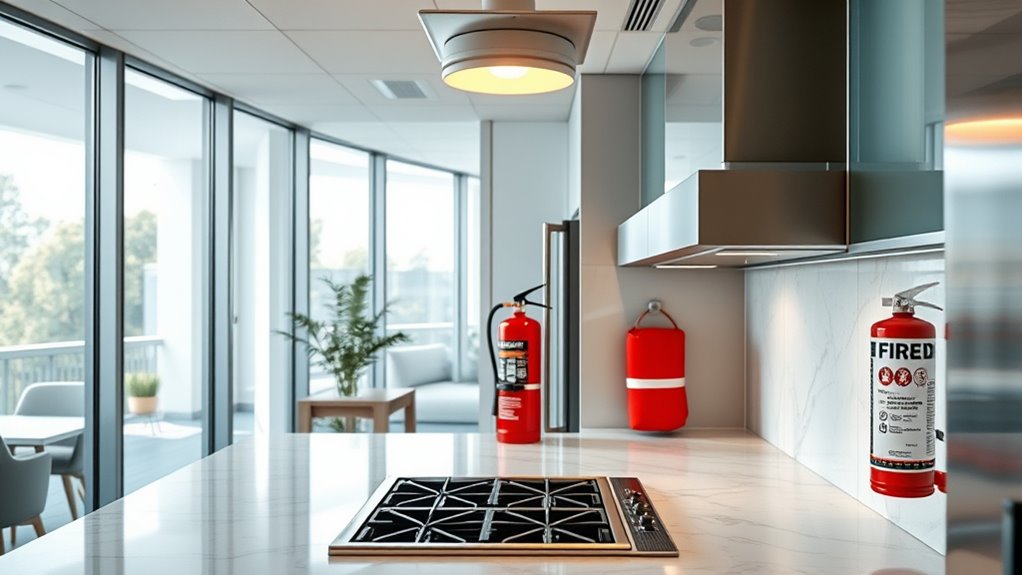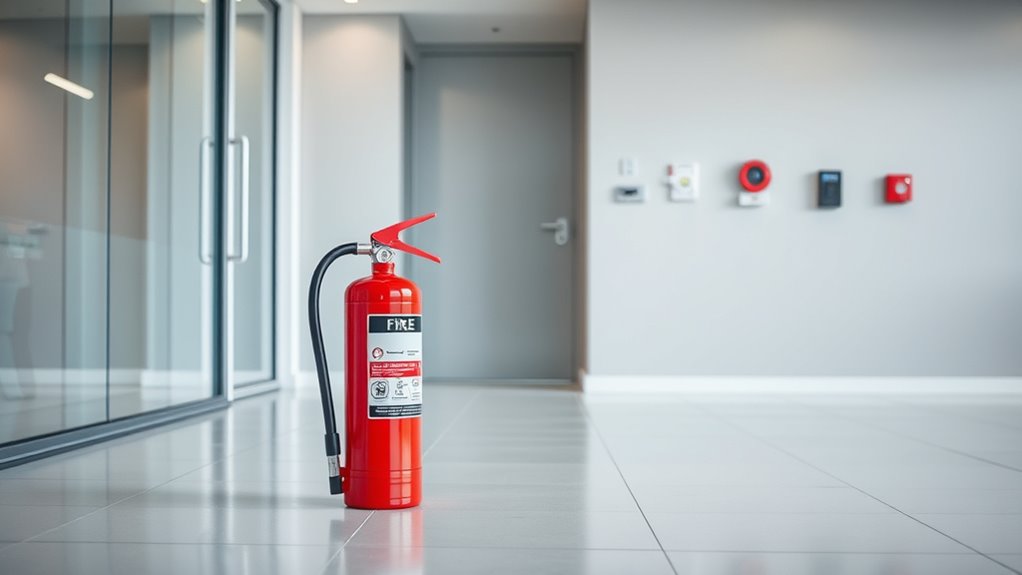To guarantee fire safety at home and in the office, install reliable smoke and heat alarms and test them regularly. Familiarize yourself with evacuation routes, keep exits clear, and conduct fire drills often. Enhance safety by installing visual alerts for those with hearing impairments and ensuring backup power for alarms. Proper safety measures can prevent accidents and save lives; understanding how to respond effectively is essential—so, explore further to learn more about safeguarding yourself and others.
Key Takeaways
- Install and regularly test reliable fire alarm systems with backup power in both home and office environments.
- Keep escape routes clear, post evacuation maps, and conduct regular drills to ensure preparedness.
- Use interconnected alarms to ensure all devices activate simultaneously during a fire.
- Maintain proper safety equipment like fire extinguishers and ensure everyone knows emergency procedures.
- Promote awareness of fire safety measures, including smoke detection, safe evacuation, and prevention strategies.

Have you ever considered how quickly a small fire can escalate into a major disaster? It’s a reminder of how essential fire safety measures are in both your home and office. One of the most effective tools you can have in place is a reliable fire alarm system. These systems are designed to detect smoke or heat early, alerting everyone instantly so they can take immediate action. When a fire alarm sounds, it’s your cue to initiate an emergency evacuation without delay. This quick response can prevent injuries, save lives, and minimize property damage. It’s imperative to ensure your fire alarm system is properly installed, regularly tested, and maintained so it functions flawlessly when needed.
Understanding how fire alarm systems work and their importance can make a notable difference in your safety plan. Modern fire alarms are interconnected, meaning if one detects danger, all alarms activate, spreading the alert throughout the building. This interconnected feature is especially helpful in larger offices or homes, ensuring no one remains unaware of the threat. When you hear the alarm, don’t hesitate—leave the premises swiftly, following your pre-planned emergency evacuation routes. Familiarize yourself with these routes so that when an emergency strikes, you can evacuate calmly and efficiently. During evacuation, avoid using elevators, as they can become inoperative or dangerous during a fire. Instead, stick to stairwells, stay low to avoid smoke inhalation, and close doors behind you if possible to slow the fire’s spread.
Additionally, having reliable backup power sources for fire alarm systems can ensure they remain operational during power outages, which are common during fires. In workplaces, it’s essential that everyone knows what to do when the fire alarm sounds. Conduct regular drills and train all occupants on evacuation procedures. Make sure exits are clear and accessible, and post evacuation maps prominently. Additionally, consider installing visual alerts for those with hearing impairments to ensure everyone is alerted in time. Having a well-practiced emergency evacuation plan, combined with a functioning fire alarm system, greatly reduces chaos and confusion during an emergency. It allows you to focus on getting everyone out safely instead of figuring out what to do next.
Ultimately, fire safety isn’t just about having the right equipment; it’s about knowing how to respond swiftly and correctly. By understanding the importance of fire alarm systems and practicing effective emergency evacuation procedures, you’re taking essential steps toward protecting yourself, your loved ones, or your colleagues. Being prepared can make the difference between a manageable situation and a tragedy. Keep your fire safety measures up to date, stay alert, and always prioritize a quick, organized response if a fire ever occurs.
Frequently Asked Questions
How Often Should Fire Drills Be Conducted at Home and in the Office?
You should conduct fire drills at home and in the office at least twice a year to guarantee everyone knows the escape plan. Incorporate these drills into your safety inspection schedule regularly, adjusting the frequency based on local regulations or specific risks. Regular practice helps identify potential hazards and improves response times, making sure everyone stays safe during an actual emergency. Consistency is key to maintaining a safe environment for all.
What Are the Best Fire-Resistant Materials for Home and Office Construction?
You should prioritize fire-resistant materials that can withstand even the fiercest flames. Use fireproof insulation to protect walls and ceilings, and apply fire-resistant coatings to surfaces for added safety. Materials like mineral-based drywall, concrete, and brick are highly effective. These options act like a shield, giving you the peace of mind that your home or office can resist fire’s fury longer, saving lives and property.
How Can Technology Enhance Fire Safety in Workplaces and Residences?
You can enhance fire safety by installing smart smoke detectors that alert you instantly on your phone, reducing response time. Additionally, using fire safety apps helps you monitor fire risks, receive safety tips, and coordinate emergency plans effortlessly. These technologies keep you informed and prepared, ensuring faster reactions and minimizing damage or injury in both workplaces and residences. Embracing these tools makes fire safety proactive and more effective.
Are There Specific Fire Safety Regulations for Historic Buildings?
Yes, historic buildings must follow fire safety regulations that balance preservation and safety. You need to guarantee fire code compliance while respecting historic preservation standards. This involves installing discreet fire detection and suppression systems, maintaining clear escape routes, and working with authorities to adapt modern safety measures without compromising the building’s integrity. Staying informed about specific regulations helps protect both the structure and its occupants effectively.
What Are the Common Causes of Electrical Fires in Homes and Offices?
Electrical malfunctions and overloaded circuits are the main causes of fires in homes and offices. You might cause a fire if you ignore faulty wiring, neglect to replace damaged cords, or plug too many devices into one outlet. Overloading circuits, using outdated wiring, or failing to address electrical issues promptly can also spark fires. To prevent this, regularly inspect your electrical system, avoid overloading outlets, and hire professionals for repairs.
Conclusion
Remember, fire safety is like locking your front door—it’s a small step that can save your life. I once heard about a family who escaped a blaze because they had working smoke detectors and a plan. Just like a fire can spread quickly, so can disaster if you’re unprepared. By staying vigilant and practicing fire safety, you’re building a shield around what matters most—your loved ones and your home. Stay safe, always.









